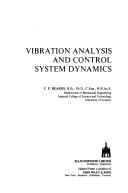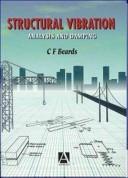| Listing 1 - 7 of 7 |
Sort by
|

ISBN: 0853122423 Year: 1981 Publisher: Chichester Horwood
Abstract | Keywords | Export | Availability | Bookmark
 Loading...
Loading...Choose an application
- Reference Manager
- EndNote
- RefWorks (Direct export to RefWorks)
534.1 --- Automatic control --- Dynamics --- Vibration --- Cycles --- Mechanics --- Sound --- Dynamical systems --- Kinetics --- Mathematics --- Mechanics, Analytic --- Force and energy --- Physics --- Statics --- Control engineering --- Control equipment --- Control theory --- Engineering instruments --- Automation --- Programmable controllers --- Vibration of bodies. Excitation of vibrations. Vibratory formations with distributed mass and elasticity --- Automatic control. --- Dynamics. --- Vibration. --- 534.1 Vibration of bodies. Excitation of vibrations. Vibratory formations with distributed mass and elasticity

ISBN: 1281033898 9786611033897 008052365X 034063183X Year: 1995 Publisher: London : Edward Arnold,
Abstract | Keywords | Export | Availability | Bookmark
 Loading...
Loading...Choose an application
- Reference Manager
- EndNote
- RefWorks (Direct export to RefWorks)
Most machines and structures are required to operate with low levels of vibration as smooth running leads to reduced stresses and fatigue and little noise. This book provides a thorough explanation of the principles and methods used to analyse the vibrations of engineering systems, combined with a description of how these techniques and results can be applied to the study of control system dynamics. Numerous worked examples are included, as well as problems with worked solutions, and particular attention is paid to the mathematical modelling of dynamic systems and the derivation of the equatio
Automatic control. --- Vibration. --- Vibration. Automatic control. --- Vibration --- Automatic control --- Civil & Environmental Engineering --- Engineering & Applied Sciences --- Civil Engineering --- Control engineering --- Control equipment --- Control theory --- Engineering instruments --- Automation --- Programmable controllers --- Cycles --- Mechanics --- Sound --- Engineering --- Mechanical Engineering

ISBN: 1281070998 9786611070991 0080518052 1591242452 9781591242451 9780080518053 9780340645802 0340645806 0470235861 9780470235867 Year: 1996 Publisher: Oxford : Butterworth-Heinemann,
Abstract | Keywords | Export | Availability | Bookmark
 Loading...
Loading...Choose an application
- Reference Manager
- EndNote
- RefWorks (Direct export to RefWorks)
Many structures suffer from unwanted vibrations and, although careful analysis at the design stage can minimise these, the vibration levels of many structures are excessive. In this book the entire range of methods of control, both by damping and by excitation, is described in a single volume.Clear and concise descriptions are given of the techniques for mathematically modelling real structures so that the equations which describe the motion of such structures can be derived. This approach leads to a comprehensive discussion of the analysis of typical models of vibrating structures exc
Structural dynamics. --- Damping (Mechanics) --- Oscillations --- Vibration --- Waves --- Building dynamics --- Dynamics, Structural --- Structural vibration --- Strains and stresses --- Structural analysis (Engineering) --- Damping (Mechanics). --- Engineering --- Civil Engineering --- Structural dynamics --- Constructions --- Dynamique

ISBN: 034063183X 9786611033897 1281033898 008052365X 9780340631836 0470235594 9780470235591 9780080523651 Year: 1996 Publisher: New York Halsted Press
Abstract | Keywords | Export | Availability | Bookmark
 Loading...
Loading...Choose an application
- Reference Manager
- EndNote
- RefWorks (Direct export to RefWorks)
Automatic control. --- Vibration. --- Engineering --- Mechanical Engineering

ISBN: 1591242452 9781591242451 9780080518053 0080518052 9780340645802 0340645806 0470235861 9780470235867 Year: 1996 Publisher: New York Halsted Press
Abstract | Keywords | Export | Availability | Bookmark
 Loading...
Loading...Choose an application
- Reference Manager
- EndNote
- RefWorks (Direct export to RefWorks)
Many structures suffer from unwanted vibrations and, although careful analysis at the design stage can minimise these, the vibration levels of many structures are excessive. In this book the entire range of methods of control, both by damping and by excitation, is described in a single volume. Clear and concise descriptions are given of the techniques for mathematically modelling real structures so that the equations which describe the motion of such structures can be derived. This approach leads to a comprehensive discussion of the analysis of typical models of vibrating structures excited by a range of periodic and random inputs. Careful consideration is also given to the sources of excitation, both internal and external, and the effects of isolation and transmissability. A major part of the book is devoted to damping of structures and many sources of damping are considered, as are the ways of changing damping using both active and passive methods. The numerous worked examples liberally distributed throughout the text, amplify and clarify the theoretical analysis presented. Particular attention is paid to the meaning and interpretation of results, further enhancing the scope and applications of analysis. Over 80 problems are included with answers and worked solutions to most. This book provides engineering students, designers and professional engineers with a detailed insight into the principles involved in the analysis and damping of structural vibration while presenting a sound theoretical basis for further study. Suitable for students of engineering to first degree level and for designers and practising engineers Numerous worked examples Clear and easy to follow.

ISBN: 9780340631836 034063183X 0470235594 9780470235591 9780080523651 008052365X Year: 1996 Publisher: New York Halsted Press
Abstract | Keywords | Export | Availability | Bookmark
 Loading...
Loading...Choose an application
- Reference Manager
- EndNote
- RefWorks (Direct export to RefWorks)
Most machines and structures are required to operate with low levels of vibration as smooth running leads to reduced stresses and fatigue and little noise. This book provides a thorough explanation of the principles and methods used to analyse the vibrations of engineering systems, combined with a description of how these techniques and results can be applied to the study of control system dynamics. Numerous worked examples are included, as well as problems with worked solutions, and particular attention is paid to the mathematical modelling of dynamic systems and the derivation of the equations of motion. All engineers, practising and student, should have a good understanding of the methods of analysis available for predicting the vibration response of a system and how it can be modified to produce acceptable results. This text provides an invaluable insight into both.
Book
ISBN: 0853125791 Year: 1983 Publisher: Chichester Horwood
Abstract | Keywords | Export | Availability | Bookmark
 Loading...
Loading...Choose an application
- Reference Manager
- EndNote
- RefWorks (Direct export to RefWorks)
| Listing 1 - 7 of 7 |
Sort by
|

 Search
Search Feedback
Feedback About UniCat
About UniCat  Help
Help News
News